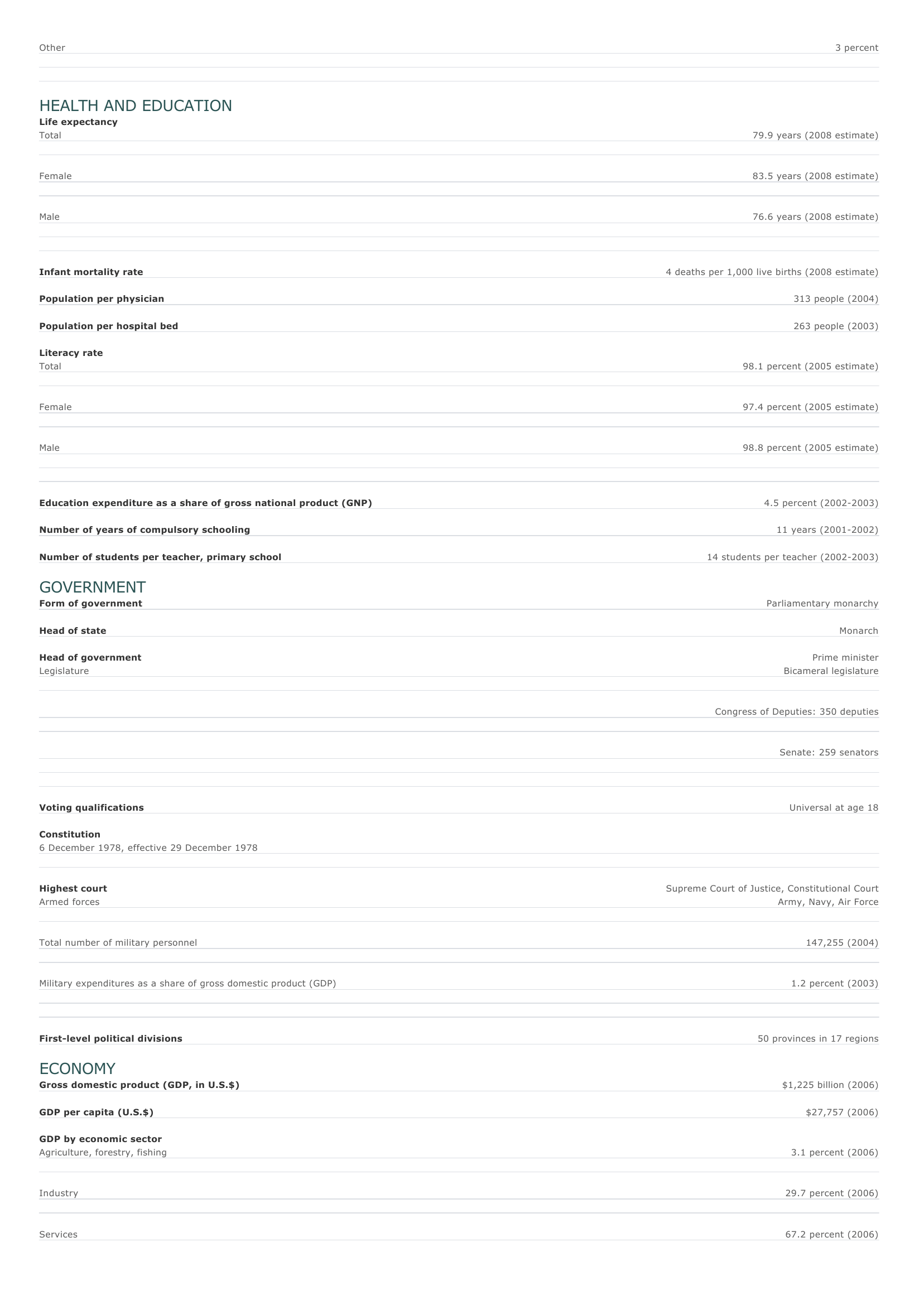Spain Facts and Figures. BASIC FACTS Official name Capital Area Kingdom of Spain Madrid 505,990 sq km 195,364 sq mi PEOPLE Population 40,491,051 (2008 estimate) Population growth Population growth rate 0.10 percent (2008 estimate) Projected population in 2025 39,578,066 (2025 estimate) Projected population in 2050 35,564,293 (2050 estimate) Population density 81 persons per sq km (2008 estimate) 210 persons per sq mi (2008 estimate) Urban/rural distribution Share urban 77 percent (2005 estimate) Share rural 23 percent (2005 estimate) Largest cities, with population Madrid 3,132,463 (2007) Barcelona 1,595,110 (2007) Valencia 797,654 (2007) Seville 699,145 (2007) Zaragoza 654,390 (2007) Ethnic groups Spanish 74 percent Catalan 16 percent Galician 8 percent B asque 2 percent Languages Castilian Spanish (official national language) 74 percent Catalan 16 percent Galician 8 percent B asque 2 percent Religious affiliations Roman Catholic 97 percent O ther 3 percent HEALTH AND EDUCATION Life expectancy Total 79.9 years (2008 estimate) Female 83.5 years (2008 estimate) Male 76.6 years (2008 estimate) Infant mortality rate 4 deaths per 1,000 live births (2008 estimate) Population per physician 313 people (2004) Population per hospital bed 263 people (2003) Literacy rate Total 98.1 percent (2005 estimate) Female 97.4 percent (2005 estimate) Male 98.8 percent (2005 estimate) Education expenditure as a share of gross national product (GNP) Number of years of compulsory schooling Number of students per teacher, primary school 4.5 percent (2002-2003) 11 years (2001-2002) 14 students per teacher (2002-2003) GOVERNMENT Form of government Head of state Head of government Legislature Parliamentary monarchy Monarch Prime minister Bicameral legislature Congress of Deputies: 350 deputies Senate: 259 senators Voting qualifications Universal at age 18 Constitution 6 December 1978, effective 29 December 1978 Highest court Armed forces Total number of military personnel Military expenditures as a share of gross domestic product (GDP) First-level political divisions Supreme Court of Justice, Constitutional Court Army, Navy, Air Force 147,255 (2004) 1.2 percent (2003) 50 provinces in 17 regions ECONOMY Gross domestic product (GDP, in U.S.$) GDP per capita (U.S.$) GDP by economic sector Agriculture, forestry, fishing $1,225 billion (2006) $27,757 (2006) 3.1 percent (2006) I ndustry 29.7 percent (2006) Services 67.2 percent (2006) Employment Number of workers Workforce share of economic sector Agriculture, forestry, fishing 21,133,333 (2006) 5 percent (2005) I ndustry 30 percent (2005) Services 65 percent (2005) Unemployment rate 11 percent (2004) National budget (U.S.$) Total revenue $332,508 million (2006) Total expenditure $308,334 million (2006) Monetary unit* 1 euro (EUR), consisting of 100 cents *The Spanish peseta (Pta) became linked to the EU single currency, the euro (EUR), on 1 January 1999 at a fixed rate of 166.386 to 1 euro (EUR). Euro coins and bills replaced the Spanish peseta as the national currency on January 1, 2002. Agriculture Grapes, potatoes, barley, wheat, almonds, tomatoes, oranges and mandarins, sugar beets, onions, wine, olive oil, cork Mining Coal, petroleum, iron ore Manufacturing Textiles, iron and steel, motor vehicles, chemicals, clothing, footwear, ships and boats, refined petroleum, cement Major exports Motor vehicles, machinery, basic metals, vegetable products, chemicals, mineral products, textiles Major imports Machinery, mineral fuels, transportation equipment, food products, metals and metal products, textiles Major trade partners for exports France, Germany, Portugal, United Kingdom, and Italy Major trade partners for imports France, Germany, Italy, United Kingdom, and Netherlands ENERGY, COMMUNICATIONS, AND TRANSPORTATION Electricity production Electricity from thermal sources 53.25 percent (2003 estimate) Electricity from hydroelectric sources 16.40 percent (2003 estimate) Electricity from nuclear sources 23.77 percent (2003 estimate) Electricity from geothermal, solar, and wind sources 6.58 percent (2003 estimate) Number of radios per 1,000 people 331 (1997) Number of telephones per 1,000 people 422 (2005) Number of televisions per 1,000 people 612 (2000 estimate) Number of Internet hosts per 10,000 people 222 (2003) Daily newspaper circulation per 1,000 people 100 (2000) Number of motor vehicles per 1,000 people Paved road as a share of total roads 558 (2003) 99 percent (2001) SOURCES Basic Facts and People sections Area data are from the statistical bureaus of individual countries. Population, population growth rate, and population projections are from the United States Census Bureau, International Programs Center, International Data Base (IDB) (www.census.gov). Urban and rural population data are from the Food and Agriculture Organization (FAO) of the United Nations (UN), FAOSTAT database (www.fao.org). Largest cities population data and political divisions data are from the statistical bureaus of individual countries. Ethnic divisions and religion data are largely from the latest Central Intelligence Agency (CIA) World Factbook and from various country censuses and reports. Language data are largely from the Ethnologue, Languages of the World, Summer Institute of Linguistics International (www.sil.org). Health and Education section Life expectancy and infant mortality data are from the United States Census Bureau, International Programs Center, International database (IDB) (www.census.gov). Population per physician and population per hospital bed data are from the World Health Organization (WHO) (www.who.int). Education data are from the United Nations Educational, Scientific and Cultural Organization (UNESCO) database (www.unesco.org). Government section Government, independence, legislature, constitution, highest court, and voting qualifications data are largely from various government Web sites, the latest Europa World Yearbook, and the latest Central Intelligence Agency (CIA) World Factbook. The armed forces data is from Military Balance. Economy section Gross domestic product (GDP), GDP per capita, GDP by economic sectors, employment, and national budget data are from the World Bank database (www.worldbank.org). Monetary unit, agriculture, mining, manufacturing, exports, imports, and major trade partner information is from the statistical bureaus of individual countries, latest Europa World Yearbook, and various United Nations and International Monetary Fund (IMF) publications. Energy, Communication, and Transportation section Electricity information is from the Energy Information Administration (EIA) database (www.eia.doe.gov). Radio, telephone, television, and newspaper information is from the United Nations Educational, Scientific and Cultural Organization (UNESCO) database (www.unesco.org). Internet hosts, motor vehicles, and road data are from the World Bank database (www.worldbank.org). Note Figures may not total 100 percent due to rounding. Microsoft ® Encarta ® 2009. © 1993-2008 Microsoft Corporation. All rights reserved.






